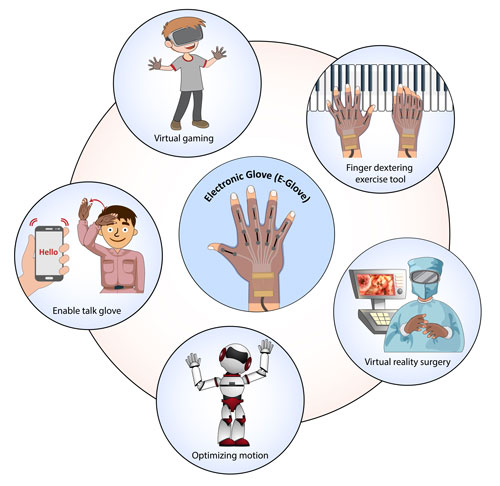| Mar 05, 2019 | |
Green and flexible protein-based electronics |
|
| (Nanowerk Spotlight) Ionic conductors are a class of materials with key roles in energy storage, solar energy conversion, sensors, and electronic devices. These materials conduct electricity through the passage of ions rather than electrons. Already, they have been used to fabricate flexible Li-ion batteries, stretchable display devices, transparent touchscreens, loudspeakers, and actuators. | |
| Since most of these devices have been made with synthetic components that often consist of highly expensive, toxic, and non-recyclable components – such as indium tin oxide – they could result in potential toxic hazards for humans and the environment, especially when discarded at the end of their lifetime. | |
| In their quest towards eco-friendly alternatives for the current type of ionic conductors, researchers have developed an alternative green option based on organic silk and inorganic synthetic nanoclay for the display and wearables industry via flexible and eco-friendly ionics. This could ultimately enable a wide range of applications within the field of flexible and wearable electronics, such as the electronic glove concept shown in the image below: | |
 |
|
| E-glove concept. (Image: DTU) (click on image to enlarge) | |
| In their paper in Advanced Science ("A Protein-Based, Water-Insoluble, and Bendable Polymer with Ionic Conductivity: A Roadmap for Flexible and Green Electronics") they demonstrate how to transform a natural polymer into an ionic material with stable performance in both aqueous and chemically active environments. | |
| "Materials scientists have long loved silk for its exceptional mechanical properties; it competes with steel in terms of the breaking strength, and spider webs are only stronger options when it comes to bending and stretching," Alireza Dolatshahi-Pirouz, an Assistant Professor in the Department of Micro- and Nanotechnology at Technical University of Denmark, tells Nanowerk. "However, silk by itself is not a stable electrical conductor and that's why we have designed our new material and shown that this property is achieved through the interaction of silk with synthetic nanoclay." | |
| By embedding a nanoclay into silk-based thin films, the researchers generated an ionic conductor that exhibits a host of highly desirable properties: good crystallinity; transparency; mechanical strength'; recyclability; optical transparency; electrical sensitivity; as well as chemical, thermal, and dimensional stability. | |
| SiPo is readily recyclable and can be recycled again and again; it is sustainable and maintains its high electrical sensitivity even after 2,000 bending cycles. SiPo could, therefore, be used in a number of devices in which high sensitivity is needed. | |
| Another promising aspect of this technology is its low-cost (US$0.62 per unit) and scalable manufacturing process. This could potentially make these sensors suitable for mass production without compromising the environment. | |
| To demonstrate the practical applicability of their technology, the researchers developed a flexible touchscreen as well as a human motion sensor that readily conforms to the curvatures of the body can measure motions from any part of the human body without any discomfort to the user. | |
| "Currently, we are developing a glove equipped with these flexible motion sensors," notes Dolatshahi-Pirouz. "Supported by DTU's Proof of Concept funding, in 10 months we will be ready with the first prototype of our E-glove, which would help surgeons to perform better in operations, translate sign language or even help the golfers improve their technique." | |
| Other application areas for wearable sensors could be to gather biological information from athletes during games; soldiers during missions; and musicians to improve their performances by helping them to gain the needed mastery of their subtle motions during strenuous activities. | |
| "Protein-based electronics still require additional consideration to enable them to resist the many demanding phenomena in nature and within the human body," cautions Dolatshahi-Pirouz. "Most of them quickly disintegrate in liquids and in response to various chemical and thermal stimuli. We will need to overcome these challenges before we could see their wide-spread use in daily life." | |
 By
Michael
Berger
– Michael is author of three books by the Royal Society of Chemistry:
Nano-Society: Pushing the Boundaries of Technology,
Nanotechnology: The Future is Tiny, and
Nanoengineering: The Skills and Tools Making Technology Invisible
Copyright ©
Nanowerk LLC
By
Michael
Berger
– Michael is author of three books by the Royal Society of Chemistry:
Nano-Society: Pushing the Boundaries of Technology,
Nanotechnology: The Future is Tiny, and
Nanoengineering: The Skills and Tools Making Technology Invisible
Copyright ©
Nanowerk LLC
|
|
|
Become a Spotlight guest author! Join our large and growing group of guest contributors. Have you just published a scientific paper or have other exciting developments to share with the nanotechnology community? Here is how to publish on nanowerk.com. |
|
